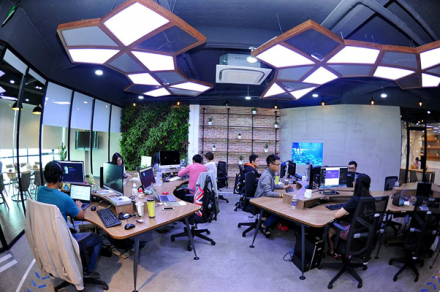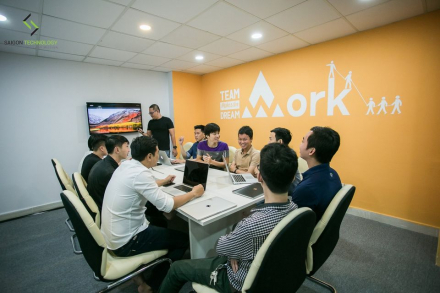It is undeniable that the overall development of a country or an organization - particularly, is always proportional to the level of science and technology that they have been applying. The world has been developing in the direction of technology, digitization in all fields from Manufacturing, Finance, Health care, Education ... to meet social demands, countries must focus on and invest in Science and Technology in general and computer technology in particular.
The computer science industry became a hot industry, computer engineers, programmers became hot jobs in many countries around the world. Terms such as application development, software development, frontend, and backend development are not difficult to come across these days. In essence, these concepts are used for programming a web application or a mobile application and it encompasses multiple skillsets, and there are different kinds of careers within the development space.
Have you ever wondered how the web/applications work? How do experts manage and control them daily? The following write-up would introduce significant fundamentals of two out of the three types of programming: front end and back end development so that even non-developers can understand, in addition, full-stack development is a combination of both front end and backend. And all the necessary information will be in this article, as we understand that it will be difficult to work with offshore engineers without much knowledge of front-end or back-end development.
Front-end & Back-end Development - How to get them correctly?
These terms sound similar enough, but what do they actually mean in the context of software development?
In software engineering, the terms front end and back end refer to the separation of concerns between the presentation layer (front end), and the data access layer (back end) of a piece of software, or the physical infrastructure of hardware.
1. What is Front-end Development?
Front-end development, also known as client-side development, handles everything that users see and interact directly with. Any aspect of a website, software package, or app that a user interacts with includes: text, images, graphs, tables, buttons, menus, and navigation panes. The core of front-end development is directly related to HTML, CSS, and JavaScript.
HTML: Hyper Text Markup Language, is the main structural component of all web or applications on the internet. HTML code ensures standard formatting of text, tables, and images. Without HTML, definitely web pages cannot exist.
CSS: Cascading Style Sheets, if you consider HTML as the backbone (structure) of a web page, CSS is like the skin outside (appearance). CSS is designed to allow programmers to present content, including layout, colors, and fonts style.
JavaScript: is a scripting language that allows you to create dynamic updates, animations, and media controls. JavaScript is important because it helps make web pages more eye-catching and interactive.
The main functions of a front end development:
- Deciding the structure and design interface of a website/application;
- Working with designers to get the style, create quality models or wireframes throughout the process;
- Optimizing user experience and speed of processing tasks and future scalability;
- Monitoring the performance of the web/application to identify potential risks and take corrective actions arising.
2. What is Back-end Development?
Back-end development, also known as server-side development is all activities that happen behind the scenes. As an engine to help launch the UI, all data is stored and processed here. End users cannot communicate with the back end, only programmers can. The back-end of a website/application usually consists of such components: server, application, and database. They are the combination of technology and programming to create and maintain the technologies needed to power a website/application. Some of the popular languages used on the back end include:
Ruby: due to it is an independent platform so that it can run smoothly on Windows, Mac, Unix versions, based on POLA (Principle Of Least Astonishment) that reduces confusion for experienced users.
Python: There is no need for the compiler to run it. This is an advanced and simple language to learn for beginners because of its easy-to-understand syntax. Python is often used with the Django framework.
PHP: The PHP language can only be interpreted by a server that has PHP installed. Compared to other languages PHP is considered a highly stable language. The popular WordPress and Facebook use PHP on their back-end - PHP has a few popular frameworks, one being Laravel.
Node.js (getting more popular - this is a backend environment for web apps built with JavaScript).
In addition to programming languages, backend development also needs a place to store big data, also known as a database, some popular backend development databases such as:
MySQL, MongoDB, PostgreSQL, ...
The main function of backend development:
- Work closely with frontend developers to provide algorithms for functional, user-oriented applications.
- Analyzing, coding, processing data, and detecting bugs and errors to provide timely improvement measures.
- Play an important role in increasing the processing speed, response time and efficiency of the website/ application.
- Backend developers are responsible for managing APIs across devices
- They are involved in the construction of the frameworks or architecture of the system to systematize the database.
3. How about full-stack development?
As a developer, one can still do well with both the front-end and the back-end, and at that point, he/she is a full-stack developer. Interestingly, by mastering the techniques of both parts, full-stack developers can create web pages and web applications that display both client-side (UI) and server-side (back end).
They don't really need to be ‘superman’ or ‘wonder woman’, but they definitely must be the ones who can work on databases, build front-end websites, and sometimes, in some cases, if necessary, they are also required to connect and communicate directly with the clients (mainly at the preliminary planning stage of going into the project).
To become a full-stack developer, engineers must specialize in a specific back-end programming language (such as Ruby, PHP, Python...), have an understanding of HTML, CSS, JavaScript, and one or more programming languages. They do not have to write all the code themselves, but for sure, they must be able to see and grasp the problem properly to see the irrationalities in the overall products and how to handle them.
Summary
In short, whether frontend or backend development plays an important role in building and developing an application or a website. There is no “more important than” factor because without 1 of 2 the website or the app would not exist. This article is not intended to have a specific purpose to guide your career in software engineering or to urge people to focus on the front-end more than the back-end.




